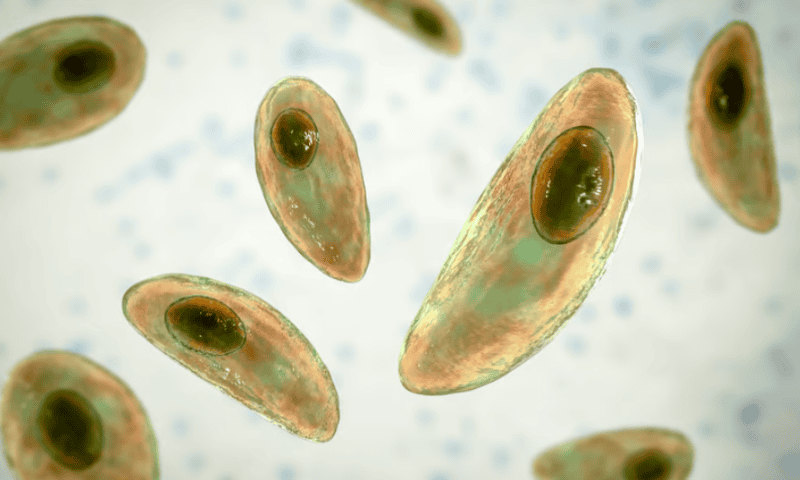Toxoplasma gondii is a protozoan parasite famous for its cunning ways. This microbial manipulator can only reproduce inside of cats, so, if it finds itself in another mammalian host, like a rat, it alters the rodent’s behavior to make it less fearful of felines. This effect has even been found in wild spotted hyena cubs, who behave more boldly toward lions when infected with T. gondii.
Now, researchers have devised a way to engineer this single-celled saboteur for good.
Neuroscientist Shahar Bracha, Ph.D., now at the Massachusetts Institute of Technology, genetically modified T. gondii to deliver drugs across the blood-brain barrier. The results, published in Nature Microbiology on July 29, present a potential new avenue for safely and effectively getting drugs to the brain to treat neurological diseases.
“This study demonstrates a turning of tables with a rare opportunity to use a parasite to better human health,” Emma Wilson, Ph.D., a biomedical researcher at the University of California, Riverside who was not involved with the study, told Fierce Biotech in an email. “A really exciting way to get to neurons that are intrinsically so well protected in the brain.”
The blood-brain barrier is a protective layer that limits which molecules can access our gray matter.
“That is very important to protect the brain, but also it makes it really hard when you do want to deliver specific things to the brain,” Bracha told Fierce Biotech. While working in a neuroscience lab, Bracha came across papers describing the pathology of T. gondii, which can cross the human blood-brain barrier to infect neurons in several ways, including potentially by hijacking immune cells.
“The more we heard about it, the more we realized it can do exactly everything we need in order to enable drug delivery to the brain,” Bracha said. She teamed up with T. gondii researchers to try to beat the manipulative parasite at its own game.
To successfully infect host cells, T. gondii uses three different protein secretion systems. Two of these hinge on structures called rhoptries and dense granules and are used to make proteins destined to infiltrate cells such as neurons. Bracha edited the genes controlling proteins made by these systems so that T. gondii would make what’s called a fusion protein, which is essentially a parasitic protein stitched together with a therapeutic protein. In a way, this turns the parasite into a living, moving, miniature drug factory.
Bracha chose to focus on a protein called methyl-CpG binding protein 2 (MecP2), because mutations in this protein are the cause of the rare neurodevelopmental disease Rett syndrome, which has no cure.
Bracha worked with T. gondii in cultured mammalian cells. She said there was a lot of uncertainty at first, because nobody had ever tried something like this before. But her perseverance paid off. “The first time I saw MecP2 was being delivered, I was at the microscope, and I was so excited,” Bracha said. “I immediately sent a message to both of my PIs with fireworks, like an actual GIF of fireworks.”
Bracha systemically showed that T. gondii could deliver MecP2 inside of cultured fibroblast cells, neurons and brain organoids before giving the engineered parasite its biggest test. She injected the protozoans into the abdomens of mice and then euthanized the rodents 18 days later. Cutting out their brains, she saw that T. gondii had successfully made it into their neurons and delivered MecP2.
Bracha’s work led to the creation of Epeius Pharma, an Israeli biotech looking to turn T. gondii into a vehicle for drug delivery. The next big step is ensuring the parasite has had its dangerous side fully stripped away in the same way that viruses used for gene therapy have been neutered and made safe.
“Toxoplasma can be fatal to the immune compromised,” Wilson said. “There is still much to be done before this becomes a disease curing procedure and that includes minimizing if not removing any chance that the parasite can cause disease in the brain.”
For Bracha, the results highlight the power of evolution to solve bioengineering problems and the importance of understanding the living things around us—her work wouldn’t have been possible without prior basic research into T. gondii’s lifestyle. “We’re accumulating understanding of what biology can do,” she said. “Describing what exists is a very powerful way to increase our toolbox.” Wilson agrees.
“An understanding of basic biology is at the route of so many if not all successful translational research,” Wilson said. “Without such understanding we may be missing opportunities or indeed risking lives.”

